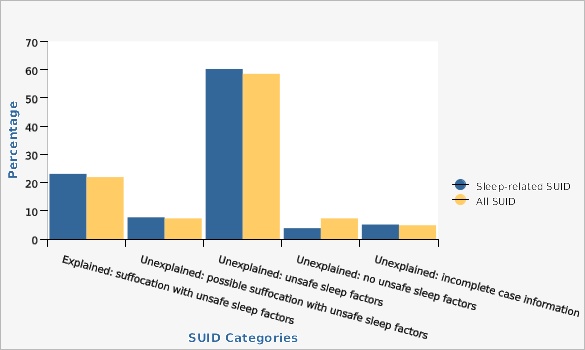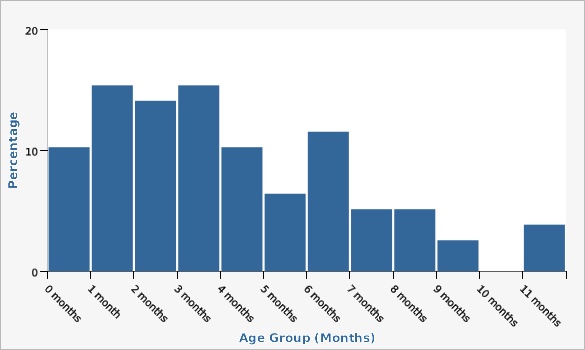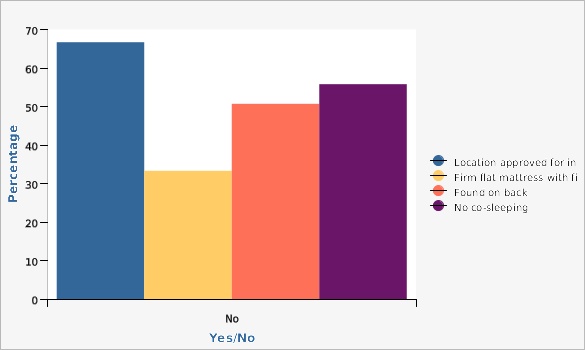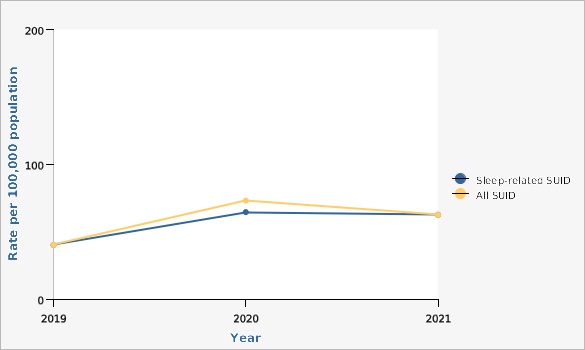Complete Health Indicator Report of Sleep-related sudden unexpected infant death (SUID)
Definition
[https://www.cdc.gov/sids/about/index.htm#:~:text=Sudden%20unexpected%20infant%20death%20(SUID,in%20the%20baby's%20sleep%20area. Sudden unexpected infant death (SUID)] is a term used to describe the sudden and unexpected death of a child less than 1 year of age in which the cause was not obvious. Sleep-related SUID happen during sleep or in the baby's sleep area and account for the vast majority of SUID cases.Numerator
The number of sleep-related sudden unexpected infant deaths and, for comparison, the total number of sudden unexpected infant deaths in Utah.Denominator
The total number of infants in Utah.Why Is This Important?
Around the same number of infants die from SUID each year as 18-year-olds die from ALL types of injury deaths (suicide, motor vehicle, poisoning, drowning, falls, etc.) and 18-year-olds die more from injury deaths than other child age groups. Sudden unexpected infant deaths include sudden infant death syndrome (SIDS), accidental suffocation in a sleeping environment, and other deaths from unknown causes. It is well understood that a large percentage of these deaths are preventable even while some research might point toward problems present in the area of an infant's brain that controls breathing and waking up from sleep. The [https://www.cdc.gov/sids/data.htm success in the 90s of the Back to Sleep campaign] is an excellent example of how promoting [https://publications.aap.org/pediatrics/article/150/1/e2022057990/188304/Sleep-Related-Infant-Deaths-Updated-2022?autologincheck=redirected the American Academy of Pediatrics' safe sleep recommendations] can help save the lives of infants.Healthy People Objective MICH-1.9:
Infant deaths from sudden unexpected infant deaths (includes SIDS, unknown cause, accidental suffocation, and strangulation in bed)U.S. Target: 0.84 infant deaths per 1,000 live births
How Are We Doing?
There has not been any significant change in the rate of SUID since the successes of the '90s Back to Sleep Campaigns, but with better data to inform prevention Utah is hoping to move the needle once again.Evidence-based Practices
[https://publications.aap.org/pediatrics/article/150/1/e2022057990/188304/Sleep-Related-Infant-Deaths-Updated-2022?autologincheck=redirected 2022 American Academy of Pediatrics Safe Sleep Recommendations] [https://www.cdc.gov/sids/Parents-Caregivers.htm#print CDC Safe Sleep Resources] - Learn what parents and caregivers can do to help babies sleep safely. [https://safetosleep.nichd.nih.gov/ Safe to Sleep] - CDC collaborates with the Eunice Kennedy Shriver National Institute of Child Health and Human Development in its Safe to Sleep campaign, formerly known as the Back to Sleep campaign. The Safe to Sleep campaign has outreach activities to spread safe sleep messages and educational materials about ways to reduce the risk of SIDS and other sleep-related infant deaths. [https://cribsforkids.org/ Cribs for Kids] - Cribs for Kids works to prevent infant sleep-related deaths by educating parents and caregivers on the importance of practicing safe sleep for their babies through programs (such as the Safe Sleep Ambassador program) and by providing portable cribs to families who, otherwise, cannot afford a safe place for their babies to sleep. [https://www.safekids.org/tip/sleep-safety-and-suffocation-prevention-tips Safe Kids Worldwide] - Find sleep safety and suffocation prevention tips from Safe Kids Worldwide, a nonprofit organization working to help families and communities keep kids safe from injuries.Related Indicators
Relevant Population Characteristics
Poverty is a common risk factor for sleep-related SUID because it can complicate a caregiver's ability to provide a safe sleep environment for their child. The ways that poverty disproportionately impacts racial and ethnic groups as well as different social norms around co-sleeping and sleep practices can also impact the rates of SUID. In the 2019-2021 data, infants who were identified as non-White or Hispanic were disproportionately impacted by SUID. Household income data was not available for analysis.Related Relevant Population Characteristics Indicators:
Related Risk Factors Indicators:
- Infant Safe Sleep
- Breastfeeding (Ever)
- Breastfeeding at 1 Year
- Breastfeeding at 3 Months and 6 Months
- Child emotional abuse, self-reported
- Child physical abuse, self-reported
- Child sexual abuse, self-reported
- Smoking Among Adults
- Immunizations - Recommended Immunizations by Age 24 Months
- Postpartum depression
- Preterm Birth
- Smoking in the third trimester of pregnancy
- Births from unintended pregnancies
- Very Preterm Birth
Related Health Status Outcomes Indicators:
Graphical Data Views
Between 2019 and 2021, 82 Utah infants died suddenly and unexpectedly. 78 of those infants died suddenly and unexpectedly in their sleep. 2020 and 2021 had significantly higher rates of all SUID and sleep-related SUID compared to 2019.
| Sleep-related SUID vs. all SUID | Year | Rate per 100,000 population | Lower Limit | Upper Limit | Numer- ator | Denom- inator |
|---|---|---|---|---|---|---|
Record Count: 6 | ||||||
| Sleep-related SUID | 2019 | 40.1 | 24.1 | 62.6 | 19 | 47,397 |
| Sleep-related SUID | 2020 | 64.4 | 43.5 | 92.0 | 30 | 46,571 |
| Sleep-related SUID | 2021 | 62.5 | 41.8 | 89.8 | 29 | 46,401 |
| All SUID | 2019 | 40.1 | 24.1 | 62.6 | 19 | 47,397 |
| All SUID | 2020 | 73.0 | 50.6 | 102.0 | 34 | 46,571 |
| All SUID | 2021 | 62.5 | 41.8 | 89.8 | 29 | 46,401 |
Data Notes
This report is meant to focus on sleep-related SUID cases. Those cases are the ones where there are population-level prevention opportunities identified. The vast majority of all SUID cases are sleep-related. With the three years of data in this report, only 4 SUID cases, all in 2020, were not sleep-related cases. All Utah data from included SUID cases was found in the National Fatality Review Case Reporting System. For 2019, the infant population estimate was provided by the National Center for Health Statistics (NCHS) through a collaborative agreement with the U.S. Census Bureau. For the years 2020 and 2021, the infant population estimates are provided by the Kem C. Gardner Policy Institute, Utah state and county annual population estimates are by single year of age and sex.Data Source
National Fatality Review Case Reporting SystemUpdated categorization of SUID cases according to the National Center for Fatality Review and Prevention Case Registry Algorithm, Utah, 2019-2021

Utah is 1 of 32 sites in the United States that participates in [https://www.cdc.gov/sids/case-registry.htm the SUID and SDY Case Registry]. As part of this SUID monitoring program, Utah collects all available information for infant deaths that meet the SUID case definition to inform an updated categorization with the five categories available in the National Center for Fatality Review and Prevention Case Registry Algorithm.
Excluding the cases that were categorized as "unexplained: incomplete case information," 92.3% of all SUID cases and 95.9% of sleep-related SUID cases fell into one of the three categories with unsafe sleep factors present. Many of the specific unsafe sleep factors present are highlighted in the "sleep-related SUID by safe sleep factors" view.
| Sleep-related SUID vs. all SUID | SUID Categories | Percentage | Numer- ator | Denom- inator | ||
|---|---|---|---|---|---|---|
Record Count: 10 | ||||||
| Sleep-related SUID | Explained: suffocation with unsafe sleep factors | 23.1% | 18 | 78 | ||
| Sleep-related SUID | Unexplained: possible suffocation with unsafe sleep factors | 7.7% | 6 | 78 | ||
| Sleep-related SUID | Unexplained: unsafe sleep factors | 60.3% | 47 | 78 | ||
| Sleep-related SUID | Unexplained: no unsafe sleep factors | 3.8% | 3 | 78 | ||
| Sleep-related SUID | Unexplained: incomplete case information | 5.1% | 4 | 78 | ||
| All SUID | Explained: suffocation with unsafe sleep factors | 22.0% | 18 | 82 | ||
| All SUID | Unexplained: possible suffocation with unsafe sleep factors | 7.3% | 6 | 82 | ||
| All SUID | Unexplained: unsafe sleep factors | 58.5% | 48 | 82 | ||
| All SUID | Unexplained: no unsafe sleep factors | 7.3% | 6 | 82 | ||
| All SUID | Unexplained: incomplete case information | 4.9% | 4 | 82 | ||
Data Notes
This report is meant to focus on sleep-related SUID cases. Those cases are the ones where there are population-level prevention opportunities identified. The vast majority of all SUID cases are sleep-related. With the three years of data in this report, only 4 SUID cases, all in 2020, were not sleep-related cases. All Utah data from included SUID cases was found in the National Fatality Review Case Reporting System. For 2019, the infant population estimate was provided by the National Center for Health Statistics (NCHS) through a collaborative agreement with the U.S. Census Bureau. For the years 2020 and 2021, the infant population estimates are provided by the Kem C. Gardner Policy Institute, Utah state and county annual population estimates are by single year of age and sex.Data Source
National Fatality Review Case Reporting SystemSleep-related SUID by age (months), Utah, 2019-2021

Over half of all sleep-related SUID from 2019-2021 happened in the first 4 months of life (55.1%).
| Age Group (Months) | Percentage | Numer- ator | Denom- inator | |||
|---|---|---|---|---|---|---|
Record Count: 12 | ||||||
| 0 months | 10.3% | 8 | 78 | |||
| 1 month | 15.4% | 12 | 78 | |||
| 2 months | 14.1% | 11 | 78 | |||
| 3 months | 15.4% | 12 | 78 | |||
| 4 months | 10.3% | 8 | 78 | |||
| 5 months | 6.4% | 5 | 78 | |||
| 6 months | 11.5% | 9 | 78 | |||
| 7 months | 5.1% | 4 | 78 | |||
| 8 months | 5.1% | 4 | 78 | |||
| 9 months | 2.6% | 2 | 78 | |||
| 10 months | 0.0% | 0 | 78 | |||
| 11 months | 3.8% | 3 | 78 | |||
Data Notes
This report is meant to focus on sleep-related SUID cases. Those cases are the ones where there are population-level prevention opportunities identified. The vast majority of all SUID cases are sleep-related. With the three years of data in this report, only 4 SUID cases, all in 2020, were not sleep-related cases. All Utah data from included SUID cases was found in the National Fatality Review Case Reporting System. For 2019, the infant population estimate was provided by the National Center for Health Statistics (NCHS) through a collaborative agreement with the U.S. Census Bureau. For the years 2020 and 2021, the infant population estimates are provided by the Kem C. Gardner Policy Institute, Utah state and county annual population estimates are by single year of age and sex.Data Source
National Fatality Review Case Reporting SystemSleep-related SUID by safe sleep factors, Utah, 2019-2021

Key safe sleep issues that were present in the 2019-2021 sleep-related SUID cases:
# 66.7% were not found in a location approved for infant sleep, like a crib or a bassinet. They were found in adult or toddler beds, swings, couches, car seats, strollers, chairs, a Moses basket, a cradleboard, or a Rock n' Play.
# 55.8% of cases with available data were not sleeping alone in their sleep space. Co-sleeping primarily occurred with caretakers but also included siblings or animals. Co-sleeping was unknown in 1 case.
# 50.7% of cases with available data were not found on their backs. According to caregivers, only 22.7% of cases with available data were not placed to sleep on their backs. The position found and position placed was unknown in 3 cases.
# 33.3% of cases with available data did not have a firm flat mattress with no soft bedding or other items in the sleep space. Other items might include blankets, comforters, pillows, cushions, sleep positioners, bumpers, clothing, stuffed animals, nursing pillows, etc. Bedding was unknown in 3 cases.
| Infant Sleep Environment | Yes/No | Percentage | Note | Numer- ator | Denom- inator | |
|---|---|---|---|---|---|---|
Record Count: 4 | ||||||
| Location approved for infant sleep | No | 66.7% | 52 | 78 | ||
| Firm flat mattress with fitted sheet and no soft bedding or other items | No | 33.3% | 3 cases bedding unknown | 25 | 75 | |
| Found on back | No | 50.7% | 3 cases sleep position unknown | 38 | 75 | |
| No co-sleeping | No | 55.8% | 1 case co-sleeping unknown | 43 | 77 | |
Data Notes
This report is meant to focus on sleep-related SUID cases. Those cases are the ones where there are population-level prevention opportunities identified. The vast majority of all SUID cases are sleep-related. With the three years of data in this report, only 4 SUID cases, all in 2020, were not sleep-related cases. All Utah data from included SUID cases was found in the National Fatality Review Case Reporting System. For 2019, the infant population estimate was provided by the National Center for Health Statistics (NCHS) through a collaborative agreement with the U.S. Census Bureau. For the years 2020 and 2021, the infant population estimates are provided by the Kem C. Gardner Policy Institute, Utah state and county annual population estimates are by single year of age and sex.Data Source
National Fatality Review Case Reporting SystemSleep-related SUID deaths by risk factors, Utah, 2019-2021

Key risk factors that were present in the 2019-2021 sleep-related SUID cases:
# 32.0% of cases with complete case information had prenatal and/or postnatal secondhand smoke exposure. Secondhand smoke exposure was unknown in 3 cases.
# 22.4% of cases with complete case information had incomplete immunizations. Immunization status was unknown in 2 cases.
# 21.1% of cases with complete case information were born prematurely. Prematurity was unknown in 2 cases.
# 2.6% of cases were homeless at the time of death, but another 9% of cases were living in the home of a relative or in foster care. An overcrowded housing situation was also noted in a few cases.
| Risk Factors | Percentage | Note | Numer- ator | Denom- inator | ||
|---|---|---|---|---|---|---|
Record Count: 4 | ||||||
| Secondhand smoke exposure | 32.0% | 3 cases secondhand smoke exposure unknown | 24 | 75 | ||
| Incomplete immunization schedule | 22.4% | 2 cases immunization status unknown | 17 | 76 | ||
| Premature birth | 21.1% | 2 cases prematuraty unknown | 16 | 76 | ||
| Housing insecurity | 2.6% | 2 | 78 | |||
Data Notes
This report is meant to focus on sleep-related SUID cases. Those cases are the ones where there are population-level prevention opportunities identified. The vast majority of all SUID cases are sleep-related. With the three years of data in this report, only 4 SUID cases, all in 2020, were not sleep-related cases. All Utah data from included SUID cases was found in the National Fatality Review Case Reporting System. For 2019, the infant population estimate was provided by the National Center for Health Statistics (NCHS) through a collaborative agreement with the U.S. Census Bureau. For the years 2020 and 2021, the infant population estimates are provided by the Kem C. Gardner Policy Institute, Utah state and county annual population estimates are by single year of age and sex.Data Source
National Fatality Review Case Reporting SystemMore Resources and Links
Evidence-based community health improvement ideas and interventions may be found at the following sites:- Centers for Disease Control and Prevention (CDC) WONDER Database, a system for disseminating public health data and information.
- United States Census Bureau data dashboard.
- Utah healthy Places Index, evidence-based and peer-reviewed tool, supports efforts to prioritize equitable community investments, develop critical programs and policies across the state, and much more.
- County Health Rankings
- Kaiser Family Foundation's StateHealthFacts.org
- Medical literature can be queried at PubMed library.
Page Content Updated On 09/22/2023,
Published on 09/26/2023

